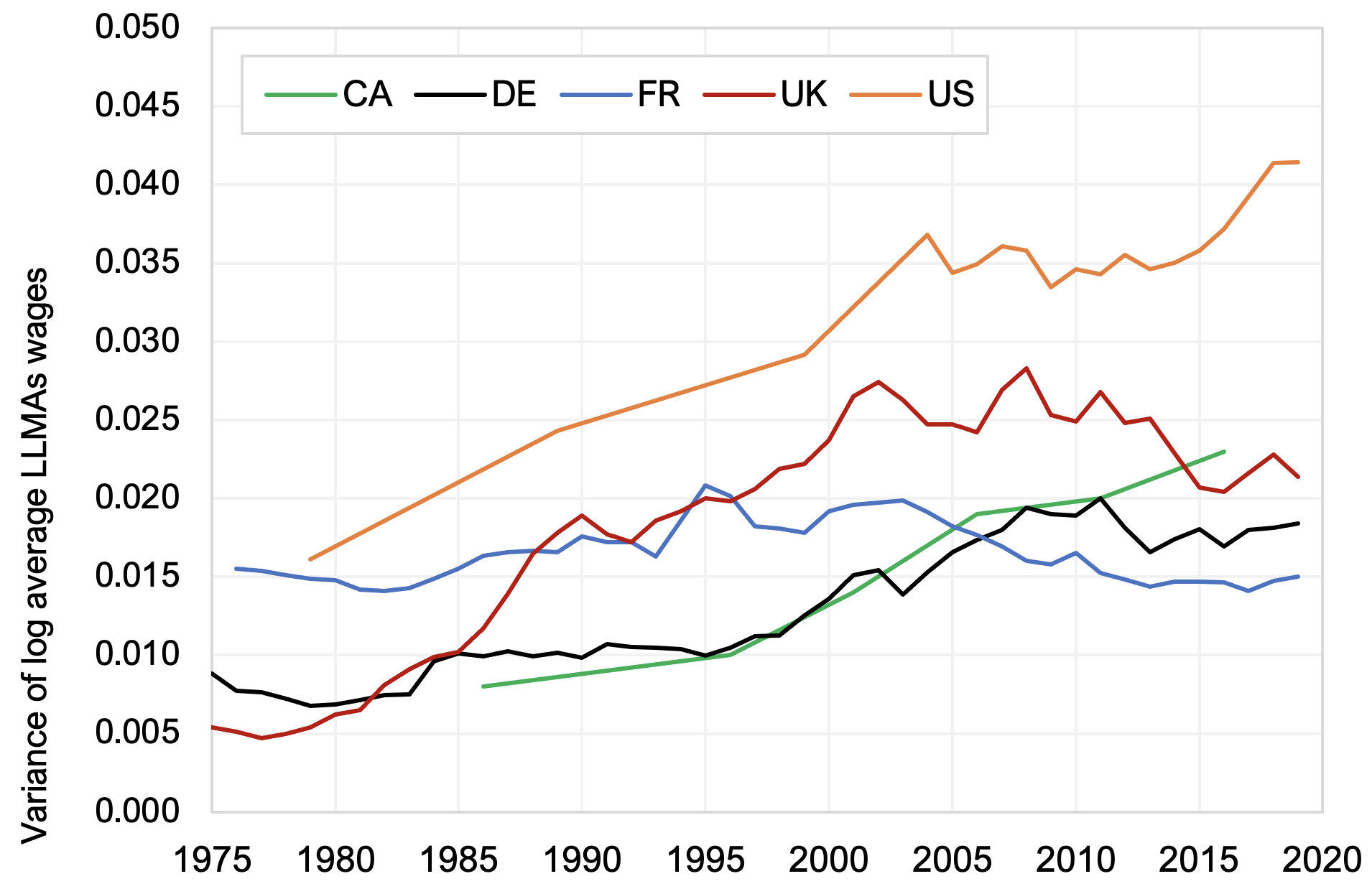Spatial inequality has become a key concern for policymakers across much of the advanced world (see Ottaviano et al. 2013, Barone et al. 2016). The European Union has long used structural funds to try and build up the economies of lagging regions, whilst in post-Brexit UK the idea of ‘levelling up’ has become an important agenda (Overman 2022). Likewise, the Biden administration has been trying to build tech clusters in the (formerly) industrial heartlands.
If policymakers are to address spatial inequalities, they need good evidence on how spatial inequality has changed over time and how this compares across countries. But making comparisons between places is a difficult task, as the controversy surrounding a misleading graph in The Economist shows. It requires comparable income data across similar spatial units, but this is hard to obtain. As a result, most analyses have focused on regional units of analysis. However, as Overman and Xu (2022) have argued, if we want to assess spatial inequality properly we need to consider local labour market units, rather than government units which will be shaped by population sorting.
How spatial inequality has evolved in five major advanced economies
We address this problem in a new paper written jointly with Sebastien Breau, Gregory Verdugo and Clement Malgouyres, in which we consider how patterns of spatial inequality have changed since the 1970s in five major advanced economies - the United States, Canada, (West) Germany, France, and the UK (Bauluz et al. 2023). Our focus is on wages, rather than incomes or productivity, but we aim to expand this in the future. We focus on labour income, reflecting the fact that the lion’s share of rising income inequality comes from this source (Atkinson et al. 2011), and consider pre-tax weekly labour income for full time workers aged 20 or above. Crucially, we use microdata sources to construct wage distributions in comparable local labour market areas across these countries, meaning that the geography we use reflects economic reality not political or administrative boundaries.
While some of our findings will be expected, some of what we find challenges the established views. First, as most people would expect, our findings show major differences in spatial inequality across countries. Figure 1 gives the variance of log mean local labour market wage, a measure of inequality between local labour markets. In 2016, the last year we have data for all countries, the US is most unequal by this measure, followed by Canada, the UK, Germany and France. But the United States is an outlier on this measure – inequalities in the other countries are relatively similar. It’s important that we put spatial inequality in other countries in context, and don’t read across from the exceptionally high levels of the US.
Figure 1 Wage inequality across local labour market areas, 1975-2019 (variance of log mean wage)
Note: Full-time workers, 20 +, weekly/daily earnings.
Source: CA: CCP; DE: SIAB; FR: DADS; UK: NES/ASHE
Now consider the trends in the data. There is a common belief that spatial inequality has been skyrocketing in recent years – but our data challenges this narrative. The US has indeed seen the large increases in spatial inequality which have dominated the established narrative. In Canada the trends are similar, as there has been a large rise in inequality, but the levels remain far lower. Nevertheless, our three European countries have seen spatial inequality fall. The UK, in particular, has seen spatial wage inequality fall since 2010 (also reported in Overman and Xu 2022). So, while it is right to say that spatial inequality has increased in all countries since the early 1980s, we shouldn’t extrapolate this trend. Since the millennium, patterns of inequality have diverged across these five countries and North America has followed a very different pattern to Europe.
It’s also important to note that these trends are driven almost entirely by the incomes of high-earners. Figure 2 shows wage inequality at the top (log 90th percentile) and bottom (log 10th percentile). While the latter has flatlined across all countries (although it is still markedly higher in the US), the former is much more variable. The lowest earners earn similar amounts wherever they are, spatial inequality is driven by the geography of the highest earners.
Figure 2 Wage inequality across local labour market areas, 1975-2019 (variance of log p90 (LHS) and log p10 wage (RHS))
Note: Full-time workers, 20 +, weekly/daily earnings.
Source: CA: CCP; DE: SIAB; FR: DADS; UK: NES/ASHE
How much does spatial inequality contribute to national inequality?
One important question is how much spatial inequality contributes to national wage inequality. One approach to this it to decompose the total variance in wages into between area and within area components (Gibbons et al. 2014). Our conclusion is that across all countries, inequalities within local labour markets contributes more than inequality between them. As shown in Figure 3, between-area inequality in mean wages contributes most to national wage inequality in the UK, with around 7% of total variation in wages explained by the contribution of local labour markets, and least in Canada, where only 3% is. The only country which has seen a significant increase in the importance of place, by this measure, is the UK.
We also illustrate the extent to which differences in average wages between areas change national wage inequality by conducting a counterfactual exercise. We equalise average wages across local labour markets, and then construct counterfactual series of national wage inequality. As you’d expect given our findings about the variation of wages, counterfactuals of national wage inequality are very close to the original observed results.
Figure 3 Share of variance of wages explained by local labour market areas, 1975-2019
Note: Full-time workers, 20 +, weekly/daily earnings.
Source: CA: CCP; DE: SIAB; FR: DADS; UK: NES/ASHE
Conclusions
To summarise our results, we show that, by the end of the last decade, spatial inequality in wages were similar in France, Germany, the UK, and Canada, but much higher in the US. Rapid growth in mean wage inequality in the 1980s and 1990s has abated since the millennium, except in the United States. And inequality by this measure has actually been falling in France which also remains the least spatially unequal country we study. But the inequality in mean area wage is not a major contributor to national inequality, contributing only 7% in the UK, the country where place matters most. On the other hand, we see that inequality between areas at the top of the distribution has continued to grow, except in France.
There are some important caveats to our results. We only consider one measure of inequality, and might come to different conclusions if we focused on productivity, wealth, or total income. Our results may change if we place more focus on inequality at the top of the distribution. Moreover, we do not (yet) account for cost of living or the incomes of the unemployed. But we think there are some important implications. We need to be careful about generalising trends from one country to others – these countries display very different patterns. These different experiences also challenge some of the dominant explanations for growing spatial inequality – about technological change, the growing importance of agglomeration, and the decline of manufacturing. We need to work harder to explain the economic processes that have produced these very different levels and trends of spatial inequality.
References
Atkinson, A B, T Piketty, and E Saez (2011), "Top Incomes in the Long Run of History", Journal of Economic Literature 49(1): 3-71.
Bauluz, L, P Bukowski, M Fransham, A Lee, M Lopez Forero, F Novokmet, S Breau, N Lee, C Malgouyres, M Schularick and G Verdugo (2023), “Spatial wage inequality in North America and Western Europe: changes between and within local labour markets 1975-2019”, CEPR Discussion Paper No. 18381.
Barone, G, F David, and G de Blasio (2016), “Boulevard of broken dreams. The end of EU funding (1997: Abruzzi, Italy)”, Regional Science and Urban Economics 60: 31-38.
Gibbons, S, H G Overman and P Pelkonen (2014), “Area Disparities in Britain: Understanding the Contribution of People vs. Place Through Variance Decompositions,” Oxford Bulletin of Economics and Statistics 76(5): 745–763.
Ottaviano, G, J Temple and H Breinlich (eds) (2013), “Regional Growth and Regional Decline”, CEPR Discussion Paper No. 9568.
Overman, H (2022), “Levelling up Europe’s left-behind places”, VoxTalk, 8 July.
Overman, H and X Xu (2022), "Spatial disparities across labour markets", IFS Deaton Review of Inequalities.















